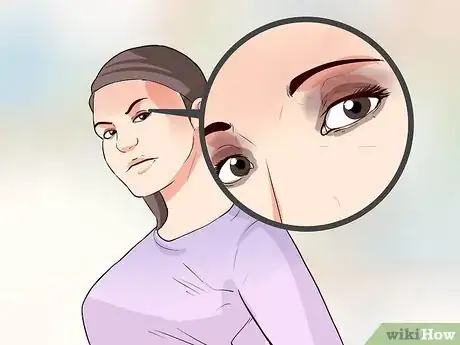This article was co-authored by Alina Bokovikova. Alina Bokovikova is a Costume Designer from California. With over 15 years of experience, she specializes in designing costumes for stage productions. Alina earned an MFA in Costume Design from the University of California, San Diego and her Master of Education from the Novosibirsk Pedagogical University. She’s won two Outstanding Costume Design awards and her costumes have been displayed in Moscow, Prague, and San Jose, California.
There are 15 references cited in this article, which can be found at the bottom of the page.
This article has been viewed 324,764 times.
A villain is usually the most fun character to play. But making that kind of evil truly scary and believable takes hard work. If you aren't sure how to act evil for your role, it helps to start from the outside and work inward. Once you have the perfect look for your evil character, you'll be able to focus on creating a sinister persona.
Steps
Looking the Part
-
1Choose the right clothing. Evil is typically associated with dark, foreboding colors, so when you’re planning a costume for a villainous character, that’s the color palette that you should start with. Black is the traditional option, but any dark shade, such as midnight blue or eggplant, can work well. Opt for clothes that have sleek, clean lines too. For example, a well-tailored suit is an attractive option for a male, while a form-fitting cocktail dress is an ideal costume for a villainess.[1]
- Shades of red can work well for an evil costume too because it’s a color usually associated with the Devil. Opt for a bold bright red if your character is outgoing, or a deep maroon or brick red for a more reserved evil look.
- Think about the fabrics that you choose for your clothing too. Leather tends to work well for evil characters, so consider incorporating a leather jacket, blazer, or vest in your costume. You can also opt for leather pants or a leather skirt.
- If your character’s evilness is a surprise that comes out during a climactic moment, you shouldn’t go with an obvious costume of head to toe black. Instead, give subtle cues with your clothing that your character might be evil, such as a black t-shirt with a basic pair of jeans.
-
2Consider the genre. When you're planning your costume, you have to take the type of play or scene that you're working in, as well as the time period, into account. For example, while a villain in a Western and an evil character in a futuristic Sci Fi play might both wear black, their outfits will likely be very different otherwise. Make sure your clothing fits the tone and time period for the character’s story.[2]
- If you're not entirely sure what's appropriate for your costume, consult movies or TV shows from the same genre for inspiration.
- If the play takes place in a specific historical period, you can also do an online search for information about clothing from the era so your costume is historically accurate.
Advertisement -
3Add sinister accessories. While your clothing will probably stand out most about your costume, small details can really help bring your evil look into focus. That’s why you should also find some accessories to help bring your villain to life. For example, edgy jewelry, such as a spiked choker or bracelet, can help give you a sinister look. Leather gloves are another item that can give your character’s costume a more menacing feel.[3]
- Your character may require a specialty accessory, such as an eye patch, that can help add to the villainous persona.
- Don’t forget weapons, such as a gun or knife, that your character might use to cause harm to others.
-
4Go for sleek hair. While there may be a variety of hairstyles that work well for your character, a sleek, slicked back do is usually the traditional look for an evil character. With short hair, that usually means just using some type of hair styling product to flatten your hair against the scalp. If you have long hair, you may want to slick your back in a similar way but pull the length into a sleek ponytail or bun.[4]
- With short hair, you'll get a more intense look by slicking it straight back rather than parting it to the side.
- Pomades work best for slicking back short hair. A clay-based formula gives you a matte finish, while an oil- or water-based pomade provides some shine, which is usually a good look if you’re on stage.
- For women with long hair, start by applying mousse to the roots of your hair before blowing it back and away from your face.
- When you’re pulling your hair into a ponytail or bun, make sure that you brush all of it back and pull it as tightly as you comfortably can. Add some gel to the sides for a wet appearance.
- Whether you have short or long hair, give your slicked back style a final spritz with hairspray to ensure that it stays in place.
- Don’t overlook facial hair. A mustache or goatee can help give you a more evil look.
-
5Go for a dramatic smoky eye. For an evil look, it usually helps to go with dark, bold makeup. Go for a dark, smoky eye shadow look, and add plenty of black eyeliner. Even male characters who aren’t wearing much other makeup can look a little more sinister with some black liner around the eyes.[5]
- For a simple smoky eye, apply a dark shade, such as black, navy, plum, brown, or charcoal, over your entire lid, blending upward toward the crease. Next, apply a light shade under your brow and blend it into your lid shade. Finish off with black liner and mascara.[6]
- Pair your smoky eye with a mean red or dark colored lipstick for a more dramatic look.
-
6Contour your face. Making your face appear more angular can help give you a more severe, menacing look. Contouring your cheeks can do the trick, so apply a brown powder directly beneath your cheekbones, from the hollow where your cheek meets your ear to below the middle of your eye. If you’re going to be on stage, create a stark line so it will stand out[7]
- Make sure to choose a brown contour shade that has gray undertones so it mimics the look of shadows.
- Use a small brush to apply the contour powder, so you keep the line defined.
-
7Develop a menacing stare. To look the part of an evil character, it’s important to have a trademark glare that you can direct at other characters -- and in some cases, the audience. Think about how people look at you when they’re angry and try to mimic the expression. You can start by narrowing your eyes and squaring your jaw. Make sure to maintain eye contact with your co-stars as well because that can very intimidating.
- Avoid looking away and blinking. Try to imagine that you’re having a staring contest with your co-stars -- that can give you a more threatening look.
- Practicing your evil stare in front of a mirror can help you perfect it. You may also want to try it out on friends and family, so they can provide feedback on how to make your look even more sinister.
Sounding the Part
-
1Make your voice deeper. While a specific character might call for a certain type of voice, villains generally have deep, throaty voice that makes them sound more evil. If you have a naturally deep voice, you probably don’t have to alter it much. However, if your voice tends to be higher-pitched, try to give it a lower, more menacing sound. That means you want to speak from your chest register, so you sound deeper and more threatening.[8]
- Identify your chest register by saying the word “whoa” in as deep a voice as you can. Keep your hand on your chest as you speak to feel the vibrations. Repeat the exercise several times. It may help to record yourself, so you can listen back to what your voice sounds like.
- If you’re having trouble connecting with your chest register, get down on the floor on all fours with your head down. Say “whoa” in as deep as voice as you can without straining yourself, and concentrate on the vibrations in your chest so you know how you should speak for a deeper sound.
- Practice your lines in your deeper voice to get used to speaking that way. You may also want to record yourself saying the lines so you can listen back and make improvements.
-
2Perfect a menacing laugh. Most evil characters have trademark laugh that makes them seem especially sinister. When you’re trying to find one for yourself, it’s important not to go too over the top, though, or you may wind up sounding like a cartoon character. The key to sounding evil is usually prolonging the laugh for an extended period. Making the laugh especially deep or loud can also help it sound more threatening.[9]
- It often helps to start with a low laugh and have it become louder and deeper as it progresses.
- The pace of your laugh can help it sound more sinister too. For example, slowing down your normal laugh may be enough to give it an evil feel.
- Consider the context of the laugh when determining what it should sound like. For example, a light hearted, joyful laugh in a scene where your character has just witnessed the death of an innocent person can sound very evil.
-
3Emphasize the right words. When you’re trying to act evil, the way you speak your lines is almost as important as the lines themselves. An villainous character should emphasize words that have a threatening connotation or mock the other characters. For example, if you tell another character, “You’re pathetic,” you may to make sure that you say “pathetic” with a hard edge so it feels like you’re really twisting the knife.[10]
- Read your lines out loud so you can hear can hear which words you should stress. Highlight them in your script to help you when you practice.
- If you’re not sure which words to emphasize, talk to your director to see what they works best for your character.
Conveying Evil
-
1Give layers to your anger. An evil character likely carries a great deal of rage, but you can’t play every scene with uncontrolled anger. Instead, try to give shades to your character’s evil rage according to the story. For example, in an early scene, you may just glare at another character to convey your low-key anger. However, as you approach the climax of the story, you may lose control and start yelling and get physical with other characters. Vary the level of anger that you show so the evil doesn’t feel one note.[11]
- Make sure that you understand what the character is angry about in every scene. It’s important to be able to justify it in your own mind.
- The amount of anger that you display should relate to what’s at stake. For example, if your character is about to lose all of his power, you should probably play full-on rage. On the other hand, if the character’s only been insulted, you may opt for more controlled anger.
-
2Enjoy the pain of others. Part of being truly evil is taking satisfaction in the misery of others. When you’re trying to act evil, it’s important to show how much joy your character gets when other people suffer -- and convey that even when you don’t have any lines that spell it out. For example, show a pleased smile when another character is crying or is worried about a loved one.[12]
- If your back is to the audience for a certain scene, laughing at another character’s misfortune is an effective alternative to smiling.
- In some cases, simply continuing to watch while another character suffers physical or emotional abuse can indicate that your character enjoys their misery.
-
3Mock others. When you’re playing an evil character, you may have lines where you taunt or make fun of other characters. But even if you don’t, there are still ways to mock them so it’s clear that your character enjoys hurting others and making them feel inferior. You can try mirroring their expression, gestures, and posture in an obvious way or simply making faces when they are speaking.[13]
-
4Project confidence. One of the reason that villains are often scary is that they have complete confidence in themselves, as well as their actions and beliefs. In fact, they’re usually the most confident characters in a story.[14] To convey that type of confidence, pay attention to your posture. Stand up straight and expand your chest, almost as if you want to take up more space. Avoid fidgeting too.[15]
- If you’re sitting down, lean back in your chair so you look as relaxed as possible.
- When you’re moving, do so in a slow, steady manner so you appear more purposeful.
Understanding the Character
-
1Decide what type of evil the character is. There are many different kinds of evil characters that you can play. Your character may be someone who started out good but was betrayed so badly that they became evil. On the other hand, they may be someone who is pure evil from the start. You’ll likely have an easier time acting evil if you understand exactly where it’s coming from.[16]
- Your evil character may be a sociopath or a psychopath. If that’s the case, it’s important to understand what that means. A sociopath typically has a weak conscience that may make them feel a little guilt after an evil act, but not enough to stop them from committing the act. A psychopath usually doesn’t have any conscience and feels no remorse for the evil acts they commit.[17]
- Sociopaths are typically a product of their environment and experiences, while psychopaths usually have their evil ingrained in them.
-
2Identify the character’s motivation. No matter what type of character you play, it is essential to understand what motivates them. However, it’s especially important with an evil character if you want to make them convincing. Three-dimensional villains usually believe that their behavior is justified, and you must know what justification your character uses. Determine what the motivation behind your character’s evil actions are, so you can make them believable.[18]
- Some evil characters are motivated by the desire for power, while others are motivated by revenge. In some cases, it may simply be the misery of others that motivates a villain.
-
3Find some humanity for the character. If your evil character doesn’t feel human to the audience, you run the risk of creating a cartoon villain. Instead, try to find your character’s humanity even amidst all the evil. Think about what might make your character cry or laugh, or the soft spots that they might have that make them feel.[19]
- In some cases, evil characters may only be able to feel for themselves, but that’s okay -- fear and self-pity are still emotions that can make a character seem human.
Community Q&A
-
QuestionI want to be evil but I don't want to hurt anyone's feelings. What can I do?
 Gregory CasamentoCommunity AnswerYou can be evil in a broad sense. Seek world domination instead of hurting people individually. The best evil is insidious and seems "good." For instance, (in DC comics) Lex Luthor is not evil. In his own mind, he's looking out for the good of humanity against the evil "Alien" who has come from Krypton to enforce his vision of "justice" on our world. From a certain point of view, Lex is absolutely right... what if Superman were evil or, maybe, from a certain perspective Superman is evil? Similarly, Darth Vader is yet another person whose "evil", when put into context, seems as though he is only following his convictions. The best "evil" character is an anti-hero.
Gregory CasamentoCommunity AnswerYou can be evil in a broad sense. Seek world domination instead of hurting people individually. The best evil is insidious and seems "good." For instance, (in DC comics) Lex Luthor is not evil. In his own mind, he's looking out for the good of humanity against the evil "Alien" who has come from Krypton to enforce his vision of "justice" on our world. From a certain point of view, Lex is absolutely right... what if Superman were evil or, maybe, from a certain perspective Superman is evil? Similarly, Darth Vader is yet another person whose "evil", when put into context, seems as though he is only following his convictions. The best "evil" character is an anti-hero. -
QuestionHow do I become super evil?
 Community AnswerActing selfishly without regard for the feelings of others will make you super evil.
Community AnswerActing selfishly without regard for the feelings of others will make you super evil. -
QuestionCan I have a high, doll-like voice and make it sound creepy?
 Community AnswerIt is difficult to make a high voice sound creepy, but it can be done. Practice speaking in a squeaky voice but weigh it down with a hoarse, "Darth Vader" tone.
Community AnswerIt is difficult to make a high voice sound creepy, but it can be done. Practice speaking in a squeaky voice but weigh it down with a hoarse, "Darth Vader" tone.
References
- ↑ http://www.geneseo.edu/~blood/CostumeDesign1.html
- ↑ http://www.geneseo.edu/~blood/CostumeDesign1.html
- ↑ http://www.geneseo.edu/~blood/CostumeDesign1.html
- ↑ http://www.gq.com/story/how-to-slick-your-hair-back
- ↑ http://www.elle.com/beauty/makeup-skin-care/tips/g2718/glamorous-makeup-for-halloween-609211/?slide=1
- ↑ http://www.southernliving.com/healthy-living/mind-body/smoky-eye-makeup
- ↑ http://www.elle.com/beauty/makeup-skin-care/tips/g8596/maleficent-makeup-how-to-mac/?slide=9
- ↑ https://spinditty.com/learning/6-Reasons-Why-You-Hate-Your-Voice
- ↑ https://www.youtube.com/watch?v=2eXZxG0PjO8
- ↑ http://www.thedramateacher.com/expressive-skills-and-realism/
- ↑ https://www.backstage.com/magazine/article/tips-finding-villain-within-10048/
- ↑ http://theweek.com/articles/447799/how-actor-even-really-nice-play-truly-evil-villain-like-king-joffrey
- ↑ http://bodyodd.nbcnews.com/_news/2010/06/14/4492770-im-not-mocking-you-i-like-you?lite
- ↑ https://www.backstage.com/magazine/article/tips-playing-villain-sons-anarchy-star-timothy-v-murphy-12880/
- ↑ http://changingminds.org/techniques/body/confident_body.htm
- ↑ https://www.backstage.com/magazine/article/tips-finding-villain-within-10048/
- ↑ http://www.webmd.com/mental-health/features/sociopath-psychopath-difference
- ↑ http://www.huffingtonpost.com/selina-wang/acting-for-stage-is-actin_b_2846846.html
- ↑ https://www.backstage.com/magazine/article/tips-finding-villain-within-10048/
About This Article
To act like an evil person, pretend that you’re selfish and hate everyone else. Speak in a deep, slow voice like a movie villain. Talk confidently and hold your head high to show you don’t care what people think of you. You can also work on your evil laugh for whenever other people suffer or make a mistake. Evil people often enjoy seeing others in pain. Be ready to snap at other people if they annoy you or let you down. Villains are often scary and have a short temper for people who don’t give them what they want. For more tips, including how to dress like an evil character, read on!











































































